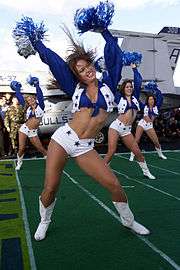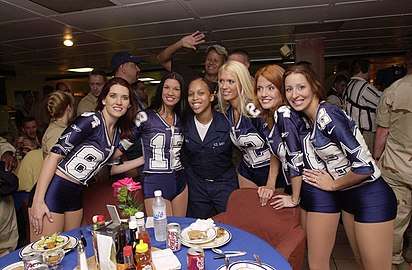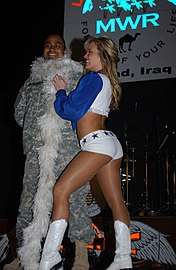Dallas Cowboys Cheerleaders
The Dallas Cowboys Cheerleaders (sometimes initialized as DCC, and officially nicknamed "America's Sweethearts") are the National Football League cheerleading squad representing the Dallas Cowboys team.[1] They started the trend of NFL cheerleading squads having young attractive women in revealing outfits dancing in front of fans.[2]
.jpg) Former cheerleader Abigail Klein | |
| Formation | 1960 (under the name "CowBelles & Beaux") |
|---|---|
Membership | 36 |
Director | Kelli Finglass |
| Affiliations | Dallas Cowboys |
| Website | www |
History
1960s
The original cheerleading squad was made up of a male-female group called the "CowBelles & Beaux". The group made its sidelines debut in 1960 during the Cowboys' inaugural season. Local high school students made up the squad, which was typical of high school and college cheerleading squads throughout the 1960s, rarely getting much attention.
During a game between the Cowboys and the Atlanta Falcons at the Cotton Bowl during the 1967 season,[3] the scantily clad, well-endowed Bubbles Cash, a stripper by profession, caused a tremendous stir in the crowd that turned to cheers when she walked down the staircase stands on the 50-yard line carrying cotton candy in each hand.[4] She became an instant public sensation in Dallas, also gaining attention from Cowboys General Manager Tex Schramm. Understanding the importance of the entertainment industry to the Cowboys' profitability, Schramm was inspired to form a cheerleading squad dressed in similar fashion to Cash.[4] By 1969, it was decided that the cheerleading squad needed this new image. The male cheerleaders were dropped from the squad, and an all-female squad from local high school cheerleading squads in the Dallas-Fort Worth area was selected. From that point on, the "CowBelles & Beaux" became the "Dallas Cowboys Cheerleaders", with new members added every year.
1970s
Preparing for the 1970 season, Schramm decided to change the Cheerleaders' image to boost attendance. At first the main change was to create an all-female squad and change the uniforms and style of cheerleading routines to be primarily dance and less like traditional acrobatic routines like that of high school or college cheerleading squads. The ten local high school cheerleaders who were selected for the 1970 season were also involved in the task of totally redesigning the uniforms and creating new dance style cheer routines under Dee Brock's direction and with the help of a choreographer. In 1971, the qualification rules changed to allow not only local female cheerleaders to compete for a spot on the squad, but also high school drill team officers. Then in 1972, Texie Waterman, a New York choreographer, was recruited and assigned to auditioning and training an entirely new female squad who would all be over 18 years of age, searching for attractive appearance, athletic ability, and raw talent as performers. Since the 1972 squad consisted of adults, this allowed the possibility of again redesigning the uniforms to introduce a more revealing look (most notably transitioning from the traditional cheerleader skirt to hot pants) closer to the classic DCC image that is known today.[5] This modified squad first appeared on the sidelines during the Cowboys' 1972 season.
Even greater national attention came in the fall of 1977 when the Cowboys, along with designer and photographer Bob Shaw, produced the first NFL cheerleader poster for the Dallas Cowboys. This, and an Esquire magazine article by Shaw in October 1977, led to the squad appearing on two network TV specials, NBC Rock-n-Roll Sports Classic and The Osmond Brothers Special on ABC. Also that year, the DCC produced their own one-hour special, The 36 Most Beautiful Girls in Texas, which aired on ABC prior to the season opener of Monday Night Football (which coincidentally was a game that the Cowboys hosted). On January 14, 1979, the made-for-TV movie The Dallas Cowboys Cheerleaders aired. Starring Bert Convy and Jane Seymour, it had a 48% share of the national television audience.[6][7]
1980s

On January 13, 1980, a sequel to the original TV movie, The Dallas Cowboys Cheerleaders II, aired. The Cheerleaders have made many other TV appearances since then, and their likeness has been featured on various merchandise, such as posters, T-shirts, trading cards, and calendars.
The DCC has also toured throughout the United States (on and off the field), as well as overseas. Included in these tours are regular appearances in United Service Organizations (USO) tours, which began during the 1979 holiday season for U.S. troops stationed in South Korea.
1990s
The DCC releases several calendars every year. More recently, in addition to their annual swimsuit calendar, they also release an annual "sideline calendar," featuring photos of the DCC cheering and performing at Cowboys home games.
The DCC held a ceremony inaugurating the second game of the 1994 FIFA World Cup between Spain and South Korea.
Former DCCs Kelli McGonagill Finglass and Judy Trammell became the squad's director and choreographer, respectively.
2000s - present
Since 2006, the Cheerleaders have produced their own reality television series, Dallas Cowboys Cheerleaders: Making the Team, which airs on Country Music Television (CMT) during the NFL football season. The series follows the auditioning process of the annual squad.
The DCC received the FIFA delegation to promote the 2022 FIFA World Cup.
The DCC also held an opening ceremony and podium at the 2013 and 2018 United States Grand Prix races in Austin, Texas.
Uniform
The uniform itself is a carefully guarded trademark and may not be duplicated in any way without the written permission of the DCC. The internationally recognized ensemble of a blue blouse, a white fringed vest with blue stars, and white hot pants with a white belt with blue stars was originally designed by Paula Van Waggoner.[8]
Modifications
Since first introduced with the formation of the squad in 1972, the basic uniform has been modified only six times:
- In May 1989, the original "go-go" boot had gone out of style, and a more western oriented design was selected.
- In 1991, the large buckled belt was left behind in favor of shorts with a more flattering cut.
- In 1992, a cowboy-style boot was introduced to the uniform.
- In 1993, crystals were added to outline the 15 stars on the vest and shorts.
- In 1994, a more western shape to the blouse lapels was incorporated.
- In 1999, crystals were added to the fringe line of the vest.
- In 2002, a western styled belt with a large buckle was added to the shorts.
Each modification has been approved by Director Kelli McGonagill Finglass and implemented by Leveta Crager, who for 24 years made and hand tailored every uniform worn by a DCC. Upon her retirement, at the start of the 1996 season, designer Greg Danison was chosen to continue the tradition of individual craftsmanship.
In February 2018, two uniforms worn by former DCCs—a current-generation uniform and a prior-generation (1970s-80s) uniform—were donated to the National Museum of American History (part of the Smithsonian Institution) in Washington, D.C., along with their respective-generation boots and pom-poms. Other items donated include DCC Barbie dolls, a sketch of the DCC uniform, and the DCC's iconic 1977 poster.
Off-field television appearances
Along with their two TV movies, the DCC has also appeared on numerous TV shows and specials as performers, guest acting roles, and game show contestants. Some of the shows on which they have appeared include:
- The Love Boat, Episodes #62 and #63 (Season 3) and #84 (Season 4)[9] – One DCC has an unwanted admirer stalking her on the ship. Another is hit on by her mom's fiancé. As a group, the DCC performs their signature routines. In the Season 4 episode entitled "Target Gopher/The Major's Wife/Strange Honeymoon/The Oilman Cometh Target Gopher", a Texas oil magnate takes the DCC aboard to impress his clients, including a Mideast prince who thinks one of the women has been given to him. Also on board are two brothers in the honeymoon suite, and an Air Force officer, his passive wife, and an aggressive ex-girlfriend.
- Family Feud – Five of the DCC participated as a team on a celebrity special for charity against five of the Cowboys players on the week of June 30 – July 4, 1980.
- Harry and the Hendersons – Guest appearance
- Billy Bob's New Year Special on CBS - Guest appearance
- Nashville Palace (Halloween special, October 1981) – The DCC appeared as guests alongside various country music artists, such as Mickey Gilley and the Oak Ridge Boys.
- Hard Knocks (2002) - Guest appearance
- Saturday Night Live - Guest appearance
- The Tonight Show with Jay Leno - Guest appearance
- Late Show with David Letterman - Guest appearance
- I Can Do That - They performed with Cheryl Burke and Nicole Scherzinger.
- Are You Smarter Than a 5th Grader? - They participated on a celebrity special for charity in 2008.
- The DCC have also appeared on a number of country music awards shows and specials since the late 1970s.
The squad also produces its own reality television series Dallas Cowboys Cheerleaders: Making the Team, which aired for each season since 2006. The series, which airs on CMT during the NFL season, chronicles the audition process and performer selection for each season's squad.
In fiction
- Dallas Cowboys Cheerleaders, a 1979 television film starring Jane Seymour.
- Dallas Cowboys Cheerleaders II, a 1980 television film starring Laraine Stephens.
- Billy Lynn's Long Halftime Walk, a 2016 film that uses the Dallas Cowboys halftime show as a central premise.
- Debbie Does Dallas is a fictionalized (and pornographic) account of a group of teenagers' efforts to join a thinly veiled version of the squad. Porn star Bambi Woods (who played the title role) had actually auditioned for the real-life DCC but didn't make the squad.[10] The DCC objected to the producer's imitation use of their uniform (which is a DCC trademark) and were able to secure injunctions to block theaters from showing the film.[11][12]
Notable DCC alumni
Many former DCCs have gone on to achieve success in show business and other notable endeavors. They include:
- Lee F. Jackson (1965–66, the CowBelles & Beaux era), Dallas County judge; served in the Texas House of Representatives from 1976 to 1986
- Janet Gunn (1980–82), actress
- Judy Trammell (1980–84), current choreographer of the DCC; mother of former DCC Cassie Trammell (2008–13)
- Brandi Redmond (2000–2002,2004–2005), current cast member of Real Housewives of Dallas (U.S. TV series)
- Kelli Finglass (1984–89), current director of the DCC
- Jill Marie Jones (1993–95), actress; plays the part of "Toni" on Girlfriends
- Bonnie-Jill Laflin (1996–97), actress/model; sportscaster and scout for the Los Angeles Lakers
- Sarah Shahi (1999–2000),[13] actress; played the part of "Carmen" on The L Word (second season); appeared in NBC's Life and the USA Network's Fairly Legal; on CBS's Person of Interest; currently star of Reverie
- Denise Garvey (2000–01); director and coach of the New York Jets' Jets Flight Crew cheerleaders; former New Jersey Nets dancer; former New York Knicks dancer
- Kristin Holt (2000–01), television personality; entertainment news correspondent
- Jenni Croft (2002–05), runner-up on The Bachelor(Season 11); former Miami Heat cheerleader; former Phoenix Suns cheerleader[14]
- Micaela Johnson (2003–05), Miss Nebraska USA 2008
- Melissa Rycroft (2006–08), former contestant and winner on ABC's Dancing with the Stars; runner-up on The Bachelor (Season 13); currently appears on Dallas Cowboys Cheerleaders: Making the Team as a consultant and advisor for DCC candidates
- Erica Kiehl Jenkins (2007–09), singer; member of The Pussycat Dolls
- Lezlie Deane, actress; founder of techno group Fem2fem
- Dianna De La Graza, mother of Demi Lovato
Gallery
 The DCC on board USS Harry S. Truman
The DCC on board USS Harry S. Truman The DCC visit U.S. sailors on board USS Nimitz.
The DCC visit U.S. sailors on board USS Nimitz.- Dallas Cowboys Cheerleaders come to a forward operating base in Iraq to entertain troops.
 The DCC cheerleading in Iraq
The DCC cheerleading in Iraq Dallas Cowboys Cheerleaders disembarking a HH-60 Pave Hawk after landing in Iraq.
Dallas Cowboys Cheerleaders disembarking a HH-60 Pave Hawk after landing in Iraq. A Dallas Cowboys cheerleader challenges Pfc. Carlos Nanez to remain completely at parade rest while she performs a cheer on stage during the Sergeant Major of the Army's Freedom and Hope USO Tour at LSA Anaconda, Iraq, Dec. 23, 2005. Nanez is a medical maintenance specialist with the 226th Medical Battalion out of Germany.
A Dallas Cowboys cheerleader challenges Pfc. Carlos Nanez to remain completely at parade rest while she performs a cheer on stage during the Sergeant Major of the Army's Freedom and Hope USO Tour at LSA Anaconda, Iraq, Dec. 23, 2005. Nanez is a medical maintenance specialist with the 226th Medical Battalion out of Germany. Dallas Cowboys Cheerleaders kickline
Dallas Cowboys Cheerleaders kickline Dallas Cowboys cheerleader Dara McFarlane signs a photo for troops at Camp Arifjan, Kuwait as part of the Army's Hope and Freedom tour to entertain deployed troops.
Dallas Cowboys cheerleader Dara McFarlane signs a photo for troops at Camp Arifjan, Kuwait as part of the Army's Hope and Freedom tour to entertain deployed troops.
References
- "Dallas Cowboys Cheerleaders: History". DallasCowboys.com. Archived from the original on 25 July 2009. Retrieved 2009-10-02.
- http://www.dallascowboys.com/content/auditions-dallas-cowboys-cheerleaders
- Shropshire, 1997 pg. 118
- Shropshire, 1997 pg. 119
- Jane, Rogers (26 February 2018). "Dallas Cowboys Cheerleaders donate iconic uniforms to the museum's sports collection". National Museum of American History. Retrieved 6 October 2019.
- Dingus, Anne. "The Dallas Cowboys Cheerleaders". Texas Monthly. Archived from the original on 7 February 2009. Retrieved 31 May 2006.
- "Dallas Cowboys Cheerleaders History". Dallas Cowboys. Archived from the original on 4 February 2007. Retrieved 31 May 2006.
- Dallas Cowboys Cheerleaders Executive Office
- "TV Land Presents The Love Boat". Archived from the original on 25 March 2006. Retrieved 31 May 2006.
- Mansour, David (2005). From Abba to Zoom: A Pop Culture Encyclopedia of the Late 20th Century. Andrews McMeel Publishing. p. 114. ISBN 0-7407-5118-2.
- Miller, Jeffrey (2002). Ardor in the Court!: Sex and the Law. ECW Press. p. 152. ISBN 1-55022-528-6.
- See Tony Farmany, 12 J. Contemp. Legal Issues 275 "TRADEMARK LITIGATION: DILUTION: Dallas Cowboys Cheerleaders v. Pussycat Cinema", citing The American Legion v. Matthew, 144 F.3d 498 (7th Cir. 1998)
- Sarah Shahi (2007) Archived 30 September 2011 at the Wayback Machine Retrieved February 9, 2007
- "Dancer Diary: Jenni - Miami Heat". NBA. Retrieved 16 January 2020.
Sources
- Shropshire, Mike. (1997). The Ice Bowl. New York, NY: Donald I. Fine Books. ISBN 1-55611-532-6